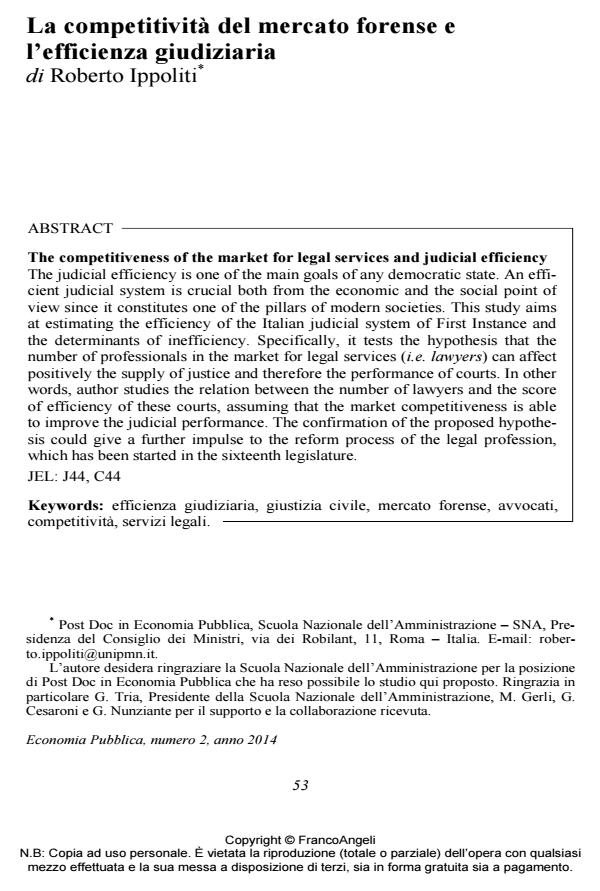The competitiveness of the market for legal services and judicial efficiency
Journal title ECONOMIA PUBBLICA
Author/s Roberto Ippoliti
Publishing Year 2014 Issue 2014/2
Language Italian Pages 38 P. 53-90 File size 938 KB
DOI 10.3280/EP2014-002003
DOI is like a bar code for intellectual property: to have more infomation
click here
Below, you can see the article first page
If you want to buy this article in PDF format, you can do it, following the instructions to buy download credits

FrancoAngeli is member of Publishers International Linking Association, Inc (PILA), a not-for-profit association which run the CrossRef service enabling links to and from online scholarly content.
The judicial efficiency is one of the main goals of any democratic state. An efficient judicial system is crucial both from the economic and the social point of view since it constitutes one of the pillars of modern societies. This study aims at estimating the efficiency of the Italian judicial system of First Instance and the determinants of inefficiency. Specifically, it tests the hypothesis that the number of professionals in the market for legal services (i.e. lawyers) can affect positively the supply of justice and therefore the performance of courts. In other words, author studies the relation between the number of lawyers and the score of efficiency of these courts, assuming that the market competitiveness is able to improve the judicial performance. The confirmation of the proposed hypothesis could give a further impulse to the reform process of the legal profession, which has been started in the sixteenth legislature.
Keywords: Efficienza giudiziaria, giustizia civile, mercato forense, avvocati, competitivita, servizi legali.
Jel codes: J44, C44
- The Efficiency of the Italian Judicial System: A Two Stage Data Envelopment Analysis Approach Eugenia Nissi, Massimiliano Giacalone, Carlo Cusatelli, in Social Indicators Research /2019 pp.395
DOI: 10.1007/s11205-018-1892-5 - Bottlenecks or Inefficiency? An Assessment of First Instance Italian Courts’ Performance Massimo Finocchiaro Castro, Calogero Guccio, in Review of Law & Economics /2015 pp.317
DOI: 10.1515/rle-2015-0030 - Measuring Potential Efficiency Gains from Mergers of Italian First Instance Courts through Nonparametric Model Massimo Finocchiaro Castro, Calogero Guccio, in Public Finance Review /2018 pp.83
DOI: 10.1177/1091142116652723 - Factors affecting judicial system efficiency: a systematic mapping review with a focus on Italy Monica Giancotti, Giorgia Rotundo, Marianna Mauro, in International Journal of Productivity and Performance Management /2024 pp.2951
DOI: 10.1108/IJPPM-05-2023-0215 - Efficiency of judicial systems: model definition and output estimation R. Ippoliti, G. Tria, in Journal of Applied Economics /2020 pp.385
DOI: 10.1080/15140326.2020.1776977 - La riforma della geografia giudiziaria: efficienza tecnica e domanda di giustizia Roberto Ippoliti, in ECONOMIA PUBBLICA 2/2016 pp.91
DOI: 10.3280/EP2015-002003 - Evaluating Judicial Service Quality At District Courts of Pakistan: An Empirical Analysis Using SERVQUAL-GAP Model Saima Sarwar, Alvina Sabah Idrees, in Public Organization Review /2025
DOI: 10.1007/s11115-025-00935-9
Roberto Ippoliti, La competitività del mercato forense e l’efficienza giudiziaria in "ECONOMIA PUBBLICA " 2/2014, pp 53-90, DOI: 10.3280/EP2014-002003